Academy of Fine Arts Vienna

The enamored Old Man, Lucas Cranach the Elder
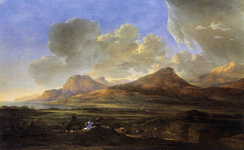
Mountainous Landscape with Traveling Herdsmen, Jan Asselijn
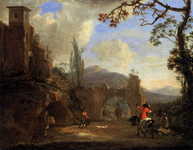
Landscape with Ruins and Hunting Party, Jan Asselijn

Coastal Scene with Resting Riders, Jan Asselijn
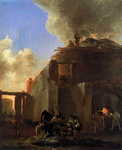
Beggars in front of a Roman Limekiln, Jan Asselijn
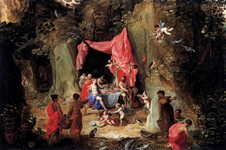
Odysseus as a Guest of the Nymph Calypso, Hendrick van Balen
 Judgement triptych : St. James of Compostela, Hieronymus Bosch
Judgement triptych : St. James of Compostela, Hieronymus Bosch

Self-Portrait as a Shepherd, Barent Fabritius
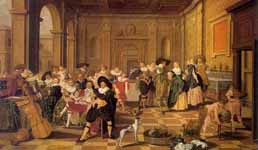
Banquet Scene in a Renaissance Hall, Dirck Hals
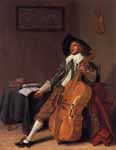
The Solo, Dirck Hals

Boy Warming himself over Embers, Bernhard Keil

Girl Binding a Wreath of Flowers, Bernhard Keil

Endymion and Selene, Filippo Lauri

Venus and Adonis, Filippo Lauri

Architectural Capriccio, François de Nomé

Merchant Vessel at Anchor, Reinier Nooms

Sine Cerere et Baccho friget Venus, Cornelis van Poelenburgh

Battle of the Cimbrians, Carl Rahl
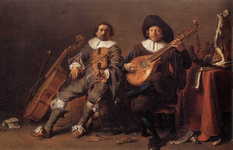
The Duet, Cornelis Saftleven

Jupiter Bids Ceres Farewell, Domenico Maria Viani

A Journey Refused, Ferdinand Georg Waldmüller
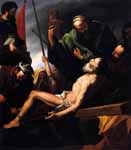
Martyrdom of St Andrew, Ferdinand Georg Waldmüller
----
Fine Art Prints | Greeting Cards | Phone Cases | Lifestyle | Face Masks | Men's , Women' Apparel | Home Decor | jigsaw puzzles | Notebooks | Tapestries | ...
----
The Academy of Fine Arts Vienna (German: Akademie der bildenden Künste Wien) is a public art school of higher education in Vienna, Austria.
History
The Academy of Fine Arts Vienna was founded in 1692 as a private academy modelled on the Accademia di San Luca and the Parisien Académie de peinture et de sculpture by the court-painter Peter Strudel, who became the Praefectus Academiae Nostrae. In 1701 he was ennobled by Emperor Joseph I as Freiherr (Baron) of the Empire. With his death in 1714, the academy temporarily closed.[1]
Life drawing room at the Vienna academy, Martin Ferdinand Quadal, 1787
On 20 January 1725, Emperor Charles VI appointed the Frenchman Jacob van Schuppen as Prefect and Director of the Academy, which was refounded as the k.k. Hofakademie der Maler, Bildhauer und Baukunst (Imperial and Royal Court Academy of painters, sculptors and architecture). Upon Charles' death in 1740, the academy at first declined, however during the rule of his daughter Empress Maria Theresa, a new statute reformed the academy in 1751. The prestige of the academy grew during the deanships of Michelangelo Unterberger and Paul Troger, and in 1767 the archduchesses Maria Anna and Maria Carolina were made the first Honorary Members. In 1772, there were further reforms to the organisational structure. Chancellor Wenzel Anton Kaunitz integrated all existing art schools into the k.k. vereinigten Akademie der bildenden Künste (Imperial and Royal Unified Academy of Fine Arts). The word "vereinigten" (unified) was later dropped. In 1822 the art cabinet grew significantly with the bequest of honorary member Anton Franz de Paula Graf Lamberg-Sprinzenstein. His collection still forms the backbone of the art on display.[2]
In 1872 Emperor Franz Joseph I of Austria approved a statute making the academy the supreme government authority for the arts. A new building was constructed according to plans designed by the faculty Theophil Hansen in the course of the layout of the Ringstraße boulevard. On 3 April 1877, the present-day building on Schillerplatz in the Innere Stadt district was inaugurated, the interior works, including ceiling frescos by Anselm Feuerbach, continued until 1892. In 1907 and 1908, young Adolf Hitler, who had come from Linz, was twice denied admission to the drawing class. He stayed in Vienna, subsisting on his orphan allowance, and tried unsuccessfully to continue his profession as an artist. Soon he had withdrawn into poverty and started selling amateur paintings, mostly watercolours, for meagre sustenance until he left Vienna for Munich in May 1913.
Anatomical room of the Akademie
During the Austrian Anschluss to Nazi Germany from 1938–1945, the academy was forced to heavily reduce its number of Jewish staff. After World War II, the academy was reconstituted in 1955 and its autonomy reconfirmed. It has had university status since 1998, but retained its original name. It is currently the only Austrian university that doesn't have the word "university" in its name.
Structure
The academy is divided into the following institutes:[3]
Institute for Fine Arts, which houses thirteen departments: Abstract Painting; Art and Digital Media; Art and Photography; Arts and Research; Conceptual Art; Contextual Painting; Expanded Pictorial Space; Figurative Painting; Graphic Arts and Printmaking Techniques; Object Sculpture; Performative Art - Sculpture; Video and Video-installation; Textual Sculpture[4]
Institute for Art Theory and Cultural Studies (art theory, philosophy, history);
Institute for Conservation and Restoration;
Institute for Natural Sciences and Technologies in Art;
Institute for Secondary School Teaching Degrees (craft, design, textile arts);
Institute for Art and Architecture.
The Academy currently has about 900 students, almost a quarter of which are foreign students. Its faculty includes "stars" such as Peter Sloterdijk. Its library houses approx. 110,000 volumes and its "etching cabinet" (Kupferstichkabinett) has about 150,000 drawings and prints. The collection is one of the biggest in Austria, and is used for academic purposes, although portions are also open to the general public.
Famous graduates
Alois Arnegger
Joannis Avramidis
Helmuth Gräff
William Berczy
Bernhard Cella
Helmut Ditsch
Joanna Gleich
Gottfried Helnwein
Wolfgang Hollegha
Hans Hollein
Alfred Hrdlička
Gottfried Lindauer
Franz Xaver Messerschmidt
Constantin Daniel Rosenthal
Egon Schiele
Rudolph Michael Schindler
Othmar Schimkowitz
Theodor Sockl
Willi Soukop
Otto Wagner
Erwin Wurm
Bruno Zach
Other students and professors
Karl Aigen (1684–1762), student, director and professor
Paul Troger (1698–1762)
Johann Georg Platzer (1704–1761)
Franz Anton Maulbertsch (1724–1796)
Joseph Mössmer (1780-1845)
Thomas Ender (1793–1875)
Konstantin Danil (1802-1873)
Albert Zimmermann (1808–1888)
Rudolf von Alt (1812–1905)
Friedrich von Schmidt (1825–1891)
Anselm Feuerbach (1829–1880), professor (1873)
Rudolph Schwarz (1840–1912)
Menci Clement Crnčić (1865–1930)
Emil Fuchs (1866-1929)
Peter Behrens (1868-1940)
Maximilian Liebenwein (1869–1926)
Alois Arnegger (1879–1963)
Clemens Holzmeister (1886–1983)
Leopold Matzal (1890-1956)
Edwin Grienauer (1893–1964)
Kurt Weiss (1895–1966)
Caspar Neher (1897–1962)
Norbert Troller (1900–1984))
Greta Kempton, (1901-1991)
Roland Rainer (1910–2004)
Ludwig Merwart (1913–1979)
Joannis Avramidis (born 1922)
Friedensreich Hundertwasser (1928–2000)
Gustav Peichl (born 1928)
Anton Lehmden (born 1929)
Ernst Fuchs (born 1930)
Harun Farocki (1944-2014)
Gottfried Helnwein (born 1948)
F. Scott Hess (born 1955)
Oz Almog, (born 1956)
Diedrich Diederichsen (born 1957)
Andrea Maria Dusl (born 1961)
Daniel Richter (born 1962)
Saeed Danosian (1979-1985)
The Academy of Fine Arts Vienna rejected Adolf Hitler twice (in 1907 and 1908), because of his "unfitness for painting".
References
"A Chronological History of the Vienna Academy of Fine Arts". Academy of Fine Arts Vienna. Retrieved November 27, 2014.
History of the art collection on the Academy's website
"Institutes". Academy of Fine Arts Vienna. Retrieved November 27, 2014.
[1][dead link]
----
Fine Art Prints | Greeting Cards | Phone Cases | Lifestyle | Face Masks | Men's , Women' Apparel | Home Decor | jigsaw puzzles | Notebooks | Tapestries | ...
----
Artist
A - B - C - D - E - F - G - H - I - J - K - L - M -
N - O - P - Q - R - S - T - U - V - W - X - Y - Z
Retrieved from "http://en.wikipedia.org/"
All text is available under the terms of the GNU Free Documentation License


